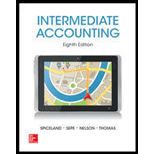
Concept explainers
Note receivable:
Note receivable refers to a written promise for the amounts to be received within a stipulated period of time. This written promise is issued by a debtor or borrower to lender or creditor. Notes receivable is an asset of a business.
To determine: The amount of cash received from the discounting of the following notes:
Answer to Problem 7.11P
| Note | Note Face Value | Date of Note | Interest Rate | Date Discounted | Discount Rate | Proceeds Received |
| 1 | $50,000 | 3/31/2016 | 8% | 6/30/2016 | 10% | $50,350 (Note1) |
| 2 | 50,000 | 3/31/2016 | 8% | 9/30/2016 | 10% | 51,675 (Note 2) |
| 3 | 50,000 | 3/31/2016 | 8% | 9/30/2016 | 12% | 51,410 (Note 3) |
| 4 | 80,000 | 6/30/2016 | 6% | 10/31/2016 | 10% | 81,027 (Note 4) |
| 5 | 80,000 | 6/30/2016 | 6% | 10/31/2016 | 12% | 80,752 (Note 5) |
| 6 | 80,000 | 6/30/2016 | 6% | 11/30/2016 | 10% | 81,713 (N ote 6) |
Table (1)
Explanation of Solution
Note 1:
Compute the amount of cash proceeds:
Working notes:
Compute the amount of interest on maturity:
Principal = $50,000
Rate of interest = 8%
Period = 9 Months (March 31, 2016 to December 31 2016)
Compute the maturity value:
Compute the amount discount on discounting the note:
Note 2:
Compute the amount of cash proceeds:
Working notes:
Compute the amount of interest on maturity:
Principal = $50,000
Rate of interest = 8%
Period = 9 Months (March 31 to December 31)
Compute the maturity value:
Compute the amount discount on discounting the note:
Note 3:
Compute the amount of cash proceeds:
Working notes:
Compute the amount of interest on maturity:
Principal = $50,000
Rate of interest = 8%
Period = 9 Months (March 31 to December 31)
Compute the maturity value:
Compute the amount discount on discounting the note:
Note 4:
Compute the amount of cash proceeds:
Working notes:
Compute the amount of interest on maturity:
Principal = $80,000
Rate of interest = 6%
Period = 6 Months (June 30 to December 31)
Compute the maturity value:
Compute the amount discount on discounting the note:
Note 5:
Compute the amount of cash proceeds:
Working notes:
Compute the amount of interest on maturity:
Principal = $80,000
Rate of interest = 6%
Period = 6 Months (June 30 to December 31)
Compute the maturity value:
Compute the amount discount on discounting the note:
Note 6:
Compute the amount of cash proceeds:
Working notes:
Compute the amount of interest on maturity:
Principal = $80,000
Rate of interest = 6%
Period = 6 Months (June 30 to December 31)
Compute the maturity value:
Compute the amount discount on discounting the note:
Want to see more full solutions like this?
Chapter 7 Solutions
Intermediate Accounting w/ Annual Report; Connect Access Card
- Equipment with a cost of $2,340,000 has an estimated salvage value of $73,000 and an estimated life of 5 years or 62,000 hours. It is to be depreciated using the units-of-activity method. What is the amount of depreciation for the first full year, during which the equipment was used for 11,500 hours?arrow_forwardI need guidance with this general accounting problem using the right accounting principles.arrow_forwardAllstate Premium Watches, Inc. had a Return on Assets (ROA) of 8.5%, a profit margin of 15.2%, and sales of $18 million. Calculate Allstate Premium Watches' total assets. (Enter your answer in millions.)arrow_forward
- I need help with this general accounting question using the proper accounting approach.arrow_forwardHorizon Industries has sales of $250,000 and the cost of goods available for sale of $215,000. If the gross profit rate is 38.75%, the estimated cost of the ending inventory under the gross profit method is?arrow_forwardCould you explain the steps for solving this financial accounting question accurately?arrow_forward

 AccountingAccountingISBN:9781337272094Author:WARREN, Carl S., Reeve, James M., Duchac, Jonathan E.Publisher:Cengage Learning,
AccountingAccountingISBN:9781337272094Author:WARREN, Carl S., Reeve, James M., Duchac, Jonathan E.Publisher:Cengage Learning, Accounting Information SystemsAccountingISBN:9781337619202Author:Hall, James A.Publisher:Cengage Learning,
Accounting Information SystemsAccountingISBN:9781337619202Author:Hall, James A.Publisher:Cengage Learning, Horngren's Cost Accounting: A Managerial Emphasis...AccountingISBN:9780134475585Author:Srikant M. Datar, Madhav V. RajanPublisher:PEARSON
Horngren's Cost Accounting: A Managerial Emphasis...AccountingISBN:9780134475585Author:Srikant M. Datar, Madhav V. RajanPublisher:PEARSON Intermediate AccountingAccountingISBN:9781259722660Author:J. David Spiceland, Mark W. Nelson, Wayne M ThomasPublisher:McGraw-Hill Education
Intermediate AccountingAccountingISBN:9781259722660Author:J. David Spiceland, Mark W. Nelson, Wayne M ThomasPublisher:McGraw-Hill Education Financial and Managerial AccountingAccountingISBN:9781259726705Author:John J Wild, Ken W. Shaw, Barbara Chiappetta Fundamental Accounting PrinciplesPublisher:McGraw-Hill Education
Financial and Managerial AccountingAccountingISBN:9781259726705Author:John J Wild, Ken W. Shaw, Barbara Chiappetta Fundamental Accounting PrinciplesPublisher:McGraw-Hill Education





